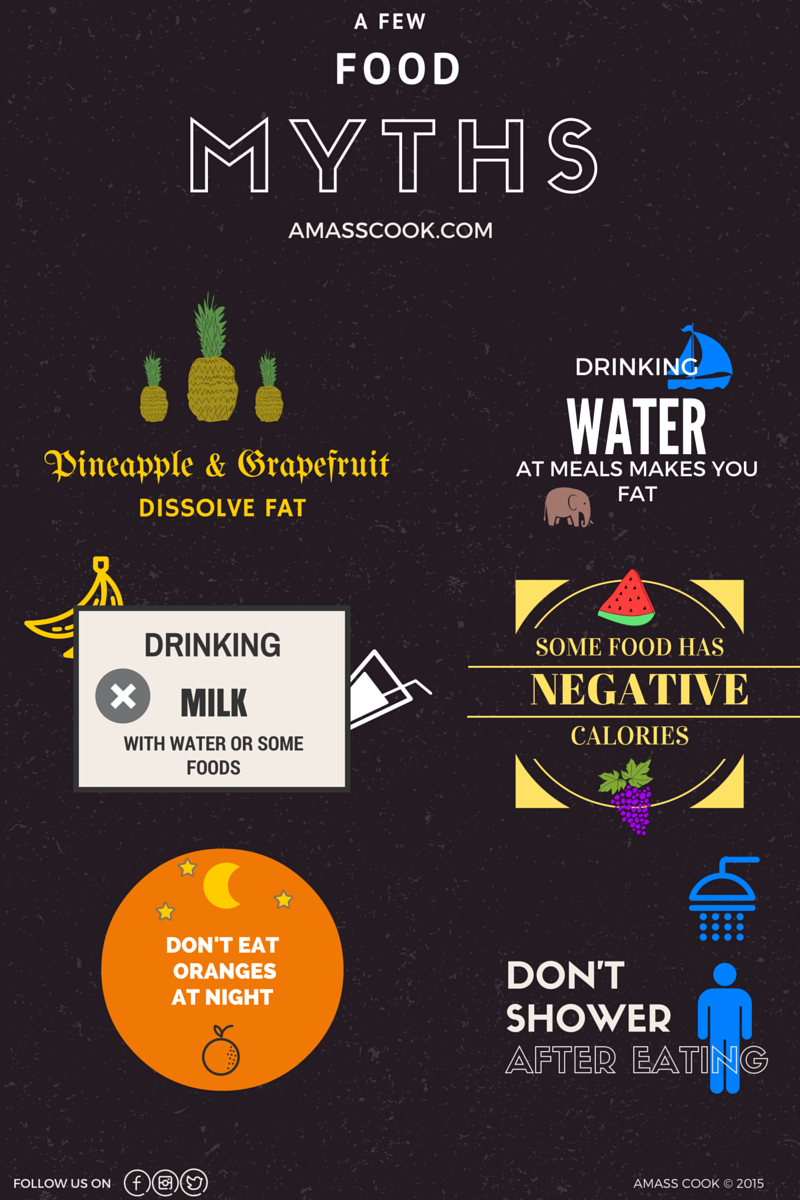Food myths
Food myths still thrive in our day to day. In a haze of rights and wrongs, some even gain the status of traditional sayings and end up being recalled as valid health advice. We won’t discriminate true from false, but aim to debunk the biology behind both parts.
Food myth N.1 – All food you eat at night will be converted in to fat?
This food myth is somehow rooted in alchemy, the only difference is that fat replaces gold as the object of desire. Or better, the unwanted one. Food is composed by several nutritional components; carbohydrates, lipids (fat) and proteins, which represent the macronutrients, and also micronutrients, such as vitamins and minerals. When ingested and digested fat is still fat. Carbohydrates, if not consumed right away, are stored in the form of fat. Proteins are broken down to amino acids, and then used to make more proteins. Not to mention that many foods are mainly composed by water, and water is absolutely not converted to fat.
Food myth N.2 – Mixing water with milk, and other foods – what’s wrong?
That is one of those classical myths we’ve all grown up with. In fact, for some it’s no longer a myth, but more of a rule. The fear of drinking water after consuming an endless list of foods such as milk, ice cream or melon is considered by some as a straightforward health advice. First of all, most fresh foods are mainly composed by water. For instance, milk and fruits are 90% composed by water. You are already ingesting (a lot of) water while eating your regular food. So, you don’t need to panic anymore about this one.
Food myth N.3 – Meat is harder to digest than vegetables?
When our digestive system is in action, it is an absolute war zone with chemical, physical and biological components. We possess the required enzymes to breakdown both animal and plant material. In fact, there isn’t a really straight forward answer for this myth, and some considerations must be taken. For instance, the cellular composition of plants is somehow more rigid/tough, due to the presence of a cell wall, than animal cells, and thus plant material is more resistant in the initial phases of digestion. On the other hand, vegetarians can complete the digestive process faster than non-vegetarians, due to a higher fiber intake [1]. So this one is still open to debate!
Food myth N.4 – Certain foods, such as apples and cucumbers, have negative calories?
This is an easy one to solve, using simple mathematics. To consume 1 kcal, one must chew during 3 minutes. So, unless we plan to chew a 100 gram apple for over two and a half hours, we’ll consume more calories than we’re wasting. In any case, this statement is kind of true, if you’re up to chew as much as it takes to burn those calories (and strain your jaw). That being said, even a 700 kcal hamburger can have “negative calories”! That is, if we’re willing to enter a 35 hour chewing marathon [2].
Food myth N.5 – Is your late night glass of milk good for your sleep?
Melatonin is a hormone which plays a role in sleep regulation, and usually kicks in after sunset, reaching its peak during the night. In fact, melatonin is one of our best allies when conquering a sound sleep. On the other hand, tryptophan is an amino acid, and is the precursor that your body needs to produce melatonin. And milk happens to have tryptophan. Cheese, eggs and meat have it too, and in greater amounts. So, drinking a glass of milk may actually contribute to a good night’s sleep [3].

References [1] - J. S. S. Gear, A. J. M. Brodribb, Alison Ware and J. I. Mannt (1981). Fibre and bowel transit times. British Journal of Nutrition, 45, pp 77-82. doi:10.1079/BJN19810078 [2] - Zamora Navarro, Salvador; Pérez-Llamas, Francisca; (2013). Errors and myths in feeding and nutrition: Impact on the problems of obesity. Nutrición Hospitalaria, Septiembre-Sin mes, 81-88. [3] - Umaraw P, Verma AK, Kumar D (2015) Designer Milk-A Milk of Intrinsic Health Benefit: A Review. J Food Process Technol 6: 426. doi: 10.4172/2157-7110.1000426

João Carvalho
Infelizmente na minha família muitos destes mitos (e até mais alguns que vocês não referiram) são o pão nosso de cada dia. Não acredito em nenhum deles, especialmente porque já provei a maioria dessas combinações e continuo aqui de boa saúde.
Gostei bastante do post!